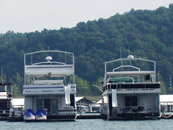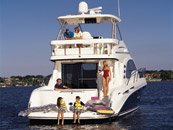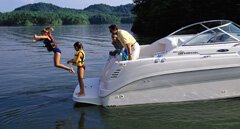A warm, cozy interior will extend your cruising season. Hereâs how to conquer the chill.
By Sven Donaldson
Logging extra days on the water in late autumn or launching into a new season ahead of the crowds can add another dimension to the boating experience. Of course, you could tough it out aboard an unheated yacht, but today thereâs really no need to be uncomfortable. Indeed, with so many proven ways to heat a boat, your toughest decision may be the choice of heating equipment to install. This overview of the most popular cabin heating methods should help you select the right system for your boat. However, when it comes down to making that final choice, itâs always a good idea to solicit the opinions of other boat owners along with suggestions from marine professionals.
Compact Space Heaters
If your cold-season boating consists of day trips between marinas with shore power available each night, you might do just fine with a combination of one or more bus heaters and 110-volt electric heaters for dockside use. The bus heater is a simple hydronic system that works like an ordinary car heater. A water pump cycles engine coolant through a closed loop between the main engine block and a small radiator in the cabin, where heat is distributed with the aid of a small electric fan blower. Bus heaters obviously wonât work with outboard power or when the propulsion engine(s) shuts down, but aside from these limitations, they offer an enticing combination of safety, reliability and low cost. Best of all, you get to harvest "free" engine heat that would otherwise go overboard with the exhaust stream.
Inexpensive electric space heaters from domestic hardware outlets will normally work satisfactorily in a dry, fully enclosed boat cabin. Look for one with a "tip-over" safety switch in its base, and avoid the old-fashioned "open coil" models that run red hot. Also, be sure your shore power system can safely handle the electrical load of one or more resistive heaters â most models typically draw 1,500 watts on the high setting.
Ceramic cube heaters are often used aboard boats, but because their fans are fairly noisy, some boaters prefer DeLonghi-style, oil-filled electric radiators. With any type of portable electric heater, itâs smart to install a ground-fault interrupter in the AC circuit and inspect the heater periodically to ensure corrosion isnât gaining a foothold.
A staggering variety of fuelburning space heaters are available today, but safety-conscious boaters will narrow the field by eliminating all but those engineered specifically for boating use. Otherwise, the risk of fuel leakage or other potentially dangerous failures is simply too great.
Stand-alone marine space heaters are ordinarily classified by fuel type with diesel, kerosene and propane currently in widespread use; liquefied natural gas and solid fuels have dropped out of favor. Regardless of fuel type, itâs vital to select a design with a properly vented burner so all exhaust gases will be discharged outside the boat. Water vapor, carbon dioxide and at least a little toxic carbon monoxide are the normal products of combustion, even with a "clean-burning" fuel such as propane. Aside from the obvious safety issues, excess water vapor from an unvented burner can quickly turn the confines of a boat cabin into something akin to a tropical rainforest.
Unlike marine furnaces, most vented cabin heaters draw combustion air from interior living spaces, but as long as the vessel has sufficient all-weather ventilation, this wonât present a safety hazard. Indeed, by enhancing air circulation, it may even help keep the bilges smelling sweeter. Of course, if the heater is constantly pulling in cold outside air, the boat may feel draftier, and there conceivably might be some extra condensation on cold surfaces, such as windows. This could be the reason some boaters believe a heater with an independent air supply results in "drier heat," but the point is debatable.
Stand-alone heaters range from massive, cast-iron diesel drip stoves to polished bulkhead heaters with windows for those who want the ambience of an open fire. A few companies build combination units that handle both cooking and cabin heating functions.
Natural draft flues, even when facilitated by balanced draft caps, may not be 100 percent reliable in gusty winds, so the more sophisticated heaters often feature forcedair combustion and exhaust venting. This combination is more expensive and complex, but boaters who have cleaned oily soot off every interior surface after a backfire in a classic diesel stove may be tempted to make the investment.
For every fuel-burning cabin heater there should be at least one carbon monoxide detector fitted nearby. By the same token, most contemporary designs have low-oxygen sensors that will interrupt the fuel supply if the incoming air supply becomes marginal, as well as a thermocoupleactuated fuel cutoff valve. Propane heaters require the same extra safety precautions as propane galley stoves: a solenoid-controlled cutoff valve at the tank locker (vented overboard, of course) and a bilge sniffer that automatically actuates the cutoff should it detect a leak.
Forced-Air Heat
Diesel-fueled forced-air heaters are popular because they offer an attractive combination of fast warm up, thermostatic temperature control and reasonably quiet operation. Compact furnaces by companies such as Espar and Webasto have become increasingly sophisticated and reliable over the years, and the recent shift to low-sulfur diesel will further reduce the incidence of burner problems.
The 3- or 4-inch ducting required by these furnaces can eat up quite a lot of stowage on smaller boats, and, in some cases, it may be more spaceefficient to install two small furnaces rather than a single large one. Power draw (for the blower, fuel pump and igniter) is occasionally a concern, but most modern boats have sufficient battery capacity to keep these systems working smoothly through a long winter night. However, bear in mind that excessive voltage drop will cause almost any advanced heating device to run poorly or even fail outright.
Reverse-Cycle Systems
Many new boats are equipped with reverse-cycle (RC) climate-control systems. Owners wishing to add (or replace) an on-board air conditioner may decide itâs worth spending more for a system that both heats and cools. Like home heat pumps, an RC unit shifts between heating and cooling modes by reserving the flow of refrigerant through the system (the condenser becomes the evaporator and vice versa).
Because watercooled condensers are the norm for marine air conditioning, in RC mode the unit pumps heat from the outside water to the boatâs interior. Naturally, the process works much better when the outside water is reasonably warm â ideally 50 degrees or higher, although some systems can cope with water temperatures as low as 40 degrees. As a rule, RC units are good for extending the season into late fall because water temperatures typically drop less abruptly than air temperatures. However, they are often less satisfactory for midwinter or spring use.
Home heat pumps can deliver big savings because the cost of electricity needed to run the compressor will be roughly one-third the cost of burning fuel to generate BTUs directly. But the potential savings are far less in the marine market because most pleasure boats are used only sporadically, and their cabins are tiny in comparison to houses. Before committing to the RC solution, consider the added wear on the compressor and seawater pump, particularly if the outside water temperature drops below 50 degrees. In some cases, itâs better to get an AC system equipped (or retrofitted) with a resistive heating coil and/or an engine coolant heat exchanger. This allows the AC blower and ducting to distribute warm air throughout the boat.
Hydronic Heating
Although more expensive than forced air, hydronic heating offers extremely quiet operation, small water pipes instead of bulky ducting and an opportunity to seamlessly integrate both engine waste heat recovery and domestic water heating. Typically, a compact, diesel-fired boiler will be plumbed to a series of radiators with one or more small electric pumps to circulate a glycol solution through the system. Proper installation and appropriate seasonal maintenance are required, of course, but these premium systems have a good reputation for reliability. With the wealth of options available, finding the right marine heating solution for your boat is not always an easy task. Key considerations include anticipated air and water temperatures, patterns of off-season use and your skill (and comfort) level with troubleshooting and maintenance. But as long as you take the time to do some homework, the generally high quality of a todayâs heating equipment makes a bad choice very unlikely.
|
Resources dickinsonmarine.comespar.com force10.com heatercraft.com itrheat.com webasto-marine.com xtremeheaters.com  |
Shared with permission by MotorBoating.



